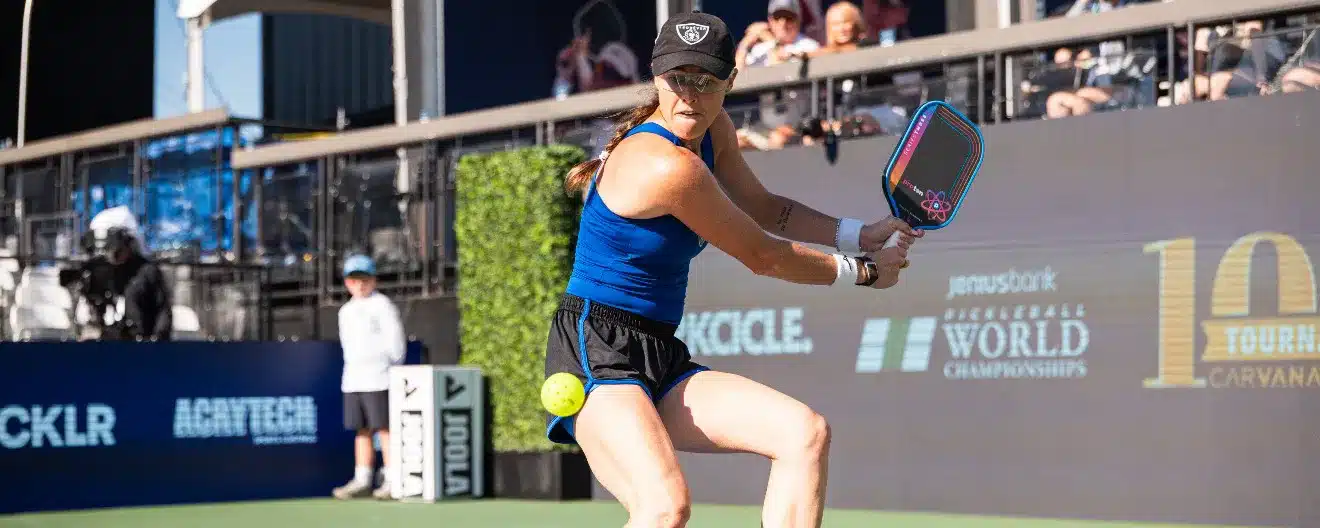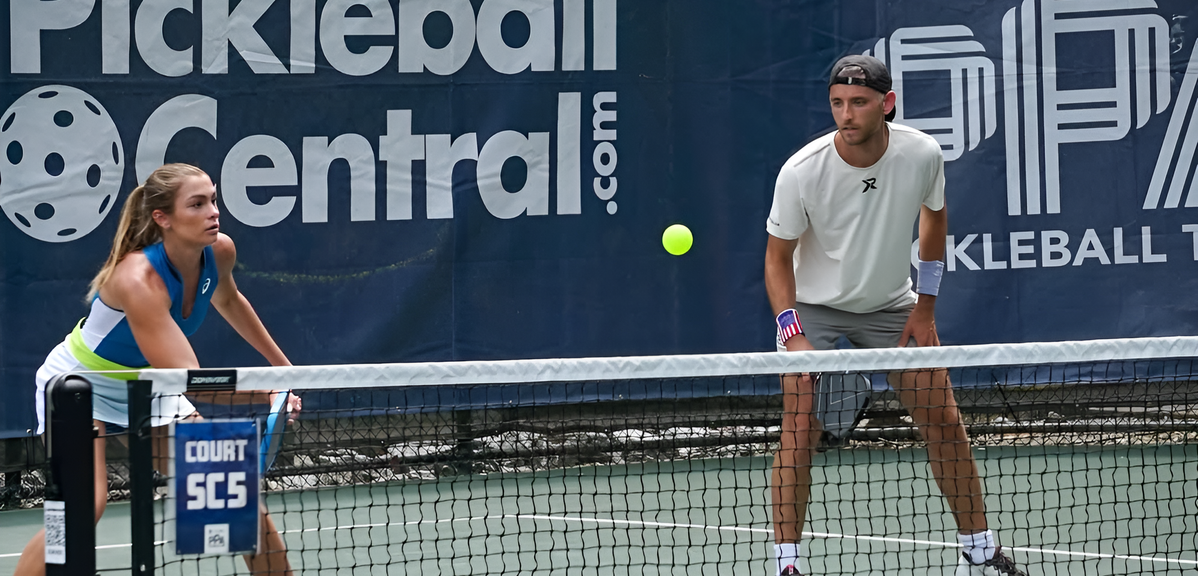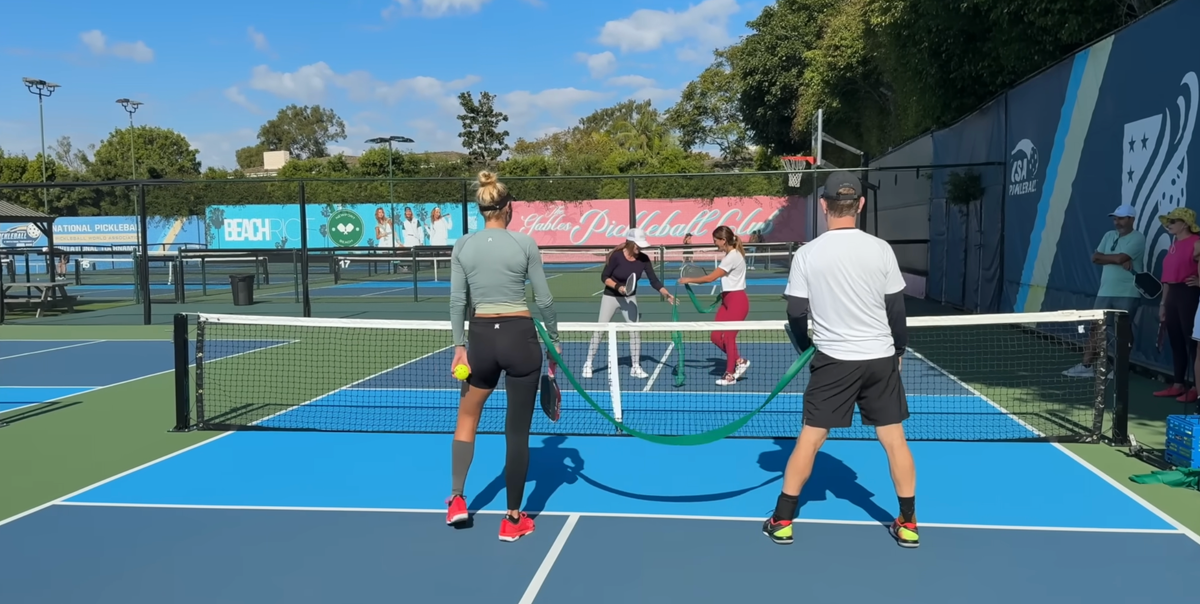What Is the Dink In Pickleball?
A pickleball dink is a drop shot executed from your kitchen line that lands in your opponent’s non-volley zone.
Since pickleball rules don’t allow you to volley inside the non-volley zone, a well-executed dink forces your opponent to let the ball bounce. Your opponent will have to hit their next shot “up” to clear the net, making it difficult for them to hit an aggressive shot.
Advantages of Dink Shots
Dink shots are especially useful against aggressive players because they slow the pace of play. The natural tendency is to return dink shots upward so that they can clear the net. Power players often hit the return of the dink into the net or out of bounds.
Most likely, your opponent will dink the ball back to you. Often, dinking continues until one player hits the ball too far and high, resulting in a smash that ends the exchange. Be patient and wait for your opponent to make an unforced error or set you up for a smash.
What is the Best Time to Use the Dink Shot?
Dink shots are commonly used starting at the fourth shot. Here’s how most pickleball games go:
- The first shot is the serve.
- The second shot is the return of serve, which is often returned deep and down the middle.
- The third shot is a drop shot. The receiving team is likely to be at the kitchen line, so the serving team will hit a drop shot into the kitchen to give themselves time to get to their own kitchen line.
- A dink is a good option for the fourth shot. Assuming the serving team has hit a well-placed drop shot, it’ll be hard to hit an aggressive return. A dink is often the safest play.
It is often necessary to hit several bank-and-forth dink shots before the opportunity arises to unleash a powerful follow-through shot.
Types of Dink Shots

Common dink shots include down-the-line dinks and cross-court dinks. Cross-court dinks typically have more strategic advantages.
The Cross-Court Dink
With a cross-court dink, you can hit longer shots that still land close to the net. The closer you can get to the net, the harder it is for your opponent to return your dink with a smash.
You tend to have a greater margin of error with cross-court shots—you’re not as likely to hit the net if your dink is low.
Cross-court dinks are better at moving your opponent out of position. Because of the trajectory of the ball, your opponent may need to run all the way out to the sideline in order to return it, opening up the middle of the court for a potential smash.
The Down-the-Line Dink
Down-the-line dinks are hit to the player directly in front of you. Although cross-court dinks tend to be the most effective, you don’t want to hit them every time because your opponents will start to expect them.
Instead, mix up your cross-court dinks with down-the-line dinks, forcing your opponents to move around the court and keeping them on their toes.
Backspin and Topspin Dinks
Topspin dinks fall into the non-volley zone faster than a ball without any spin. Once it hits the court, it moves quickly. This makes it an unpredictable shot to return. Your opponent may find themselves out of position, and their return is more likely to be imprecise.
Backspin dinks are another good move in your arsenal. Rather than speeding up when hitting the court, backspin dinks are slower to move forward and unpredictable to return.
How to Hit a Dink Shot
Here’s the best method for hitting a dink shot:
- Choose your Opponents Carefully: The dink works best against players who are hard-hitting. In a fast-paced, hard-hitting rhythm, the dink slows things down.
- Shot Selection and Timing: Dinks are often used when returning a drop shot. Let the ball bounce once, reach its apex, and begin to fall before hitting it.
- Use the Right Grip: Dink shots are best hit with an open-faced paddle and a light grip, allowing you to hit soft underhand shots. The continental grip is typically best suited to a dink.
- Positioning: Aim a little over the net in order to give yourself a margin of error. Let your opponent make the mistakes.
How to Practice Dinks
To practice dinks, find a partner and stand just outside the kitchen on opposite sides of the net.
- Stand on the non-volley zone line.
- Have your partner hit a dink into your non-volley zone.
- Wait until the ball bounces before entering the non-volley zone. When the ball reaches its peak and begins to fall, hit it upward in a gentle arc over the net into your partner’s non-volley zone.
- Practice down-the-line dinks and cross-court dinks of varying intensity, height, and angles.
Mixing Up Your Dink Shots

In pickleball, the more unpredictable you are, the more likely you’ll catch your opponents off guard and force an error. That’s why it’s important to switch up the spin, speed, angle, depth, and placement of your dink shots. You have plenty of combinations to work with:
- Speed: slow, medium, fast
- Placement: down-the-line, cross-court, middle
- Spin: backspin, topspin, no spin
Vary your play with these dink shots, and you’ll find yourself with an advantage against your opponent in no time:
- Cross-court dink: Allows you to hit at a natural angle and may force your opponent to get out of position.
- Down-the-line dink: Keeps your opponents moving around the court when combined with cross-court dinks. It can be easier to execute than a cross-court dink, and may also be the preferable option if your opponents are out of position.
- Middle Dinks: Middle dinks can be used to cause confusion between your opponents. Especially if you’re playing against opponents who haven’t played together much (and don’t have great communication), middle dinks can cause chaos. Middle dinks can also be a good setup before hitting to the sidelines since both opposing players are likely to run toward the middle of the court.
- Low Dinks: You can apply pressure by dinking at or near your opponent’s feet. It’s difficult for most players to aggressively return a pickleball from this position.
- Dink to Backhand: The majority of pickleball players have weaker backhand shots than forehand shots. Dinking to your opponent’s backhand can be an effective dinking strategy.
How useful was this post?
Click on a star to rate it!
We are sorry that this post was not useful for you!
Let us improve this post!
Tell us how we can improve this post?
Anuncie Aqui / Advertise Here
Sua marca para o mundo Pickleball! / Your brand for the Pickleball world!

 English
English  Spanish
Spanish  Portuguese
Portuguese  German
German  Italian
Italian  Japanese
Japanese  French
French  Polish
Polish  Russian
Russian  Netherlands
Netherlands  Hungarian
Hungarian  Turkish
Turkish  Videos
Videos  Pickleball Union
Pickleball Union








 English (US) ·
English (US) ·  Portuguese (BR) ·
Portuguese (BR) ·